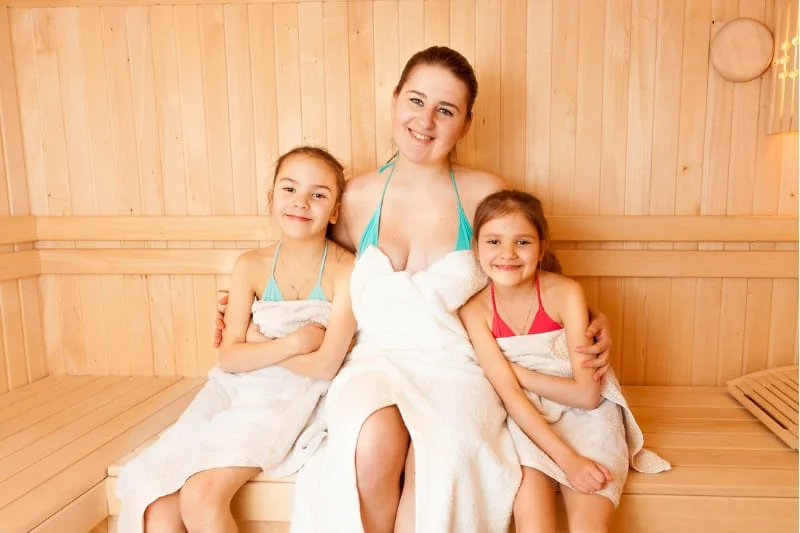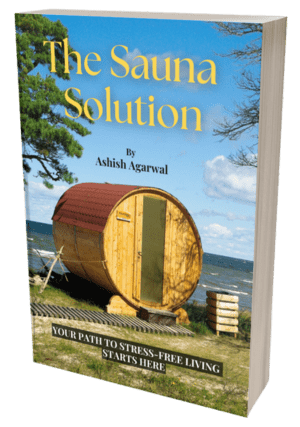Can Kids Use Saunas? Health Benefits & Safety Guidelines for Children

Have you ever wondered if your kids could join you in the sauna? You’re not alone! Many parents are curious about sharing this relaxing ritual with their children.
In Finland, where saunas are part of daily life, kids as young as 6 months participate in family sauna time. But is it safe? What are the rules? And could it actually help your child’s health?
The good news is that most healthy kids can enjoy saunas when you follow some simple guidelines. Let’s explore everything you need to know about kids and saunas!
Table of Contents
Age-Appropriate Sauna Guidelines
Not all kids are ready for the sauna at the same age. Here’s what experts recommend:
- Toddlers (under 3): Limit sessions to just 3-5 minutes. Their tiny bodies heat up much faster than adults. Make sure they’re toilet trained before bringing them to a sauna. Some experts suggest waiting until age 3 for any sauna exposure.
- Young children (3-6): Keep sessions brief at 5-10 minutes. Have them sit on the lowest bench where it’s cooler. Make it playful rather than challenging.
- School-age children (7-12): Sessions can extend to 15 minutes. They can start to learn about listening to their body’s signals. Allow breaks if they feel too warm.
- Teenagers (13+): Can handle adult-like sessions but should still start with shorter times. Many teens enjoy the skin-clearing benefits of regular sauna use.
Kids heat up faster than adults because of their larger surface area compared to their body mass. Their sweat glands aren’t fully developed either, making it harder for them to cool down naturally.
Safety First: What Every Parent Should Know
Safety is the top priority when introducing kids to saunas. Follow these guidelines:
- Temperature control: Keep temperatures between 105-130°F (40-55°C) for kids – lower than adult settings.
- Hydration is crucial: Make sure your child drinks water before and after sessions. Dehydration happens quickly in heat.
- Constant supervision: Never leave children alone in a sauna, even teenagers. Watch for signs of discomfort or overheating.
- Smart seating: Have kids sit on the lowest bench, which is the coolest spot in the sauna. Keep them away from heaters and hot rocks.
- Cooling off properly: After each session, help kids cool down gradually with a lukewarm shower. Jumping straight into cold water can be shocking to their system.
Warning signs to watch for: Pull your child out of the sauna if you notice:
- Flushed face beyond normal pinkness
- Complaints of dizziness
- Unusual quietness
- Excessive sweating
- Nausea or headache
Check with your doctor: Before starting sauna sessions, talk to your child’s pediatrician, especially if they have any health conditions like asthma, heart issues, or skin problems.
Health Benefits of Sauna for Children
Research shows that saunas can offer several health benefits for kids when used properly:
Stronger immune system
The gentle heat may help boost your child’s natural defenses. A study in the Journal of Human Kinetics found that regular sauna use reduced the risk of common colds in adults, with similar benefits likely for children. [Hussain & Cohen (2018)]
Better sleep
Many parents report that kids sleep more soundly after sauna sessions. The warming and cooling process helps trigger natural sleepiness.
Faster muscle recovery
For active kids who play sports, sauna time can ease sore muscles and speed up recovery. The increased blood flow helps remove waste products from muscle tissue.
Stress reduction
The quiet, peaceful environment of a sauna helps calm active minds. This is especially helpful for kids with anxiety or focus challenges.
Skin health improvements
For teenagers dealing with acne, sauna sessions can help open pores and improve circulation to the skin. A 2018 study in Scientific Reports linked sauna use with better skin hydration and barrier function. [Kowatzki et al. (2008)]
Brain development
Regular heat exposure triggers the release of Brain-Derived Neurotrophic Factor (BDNF), a protein that helps form new brain connections and supports learning. A research study by Glazachev (2020) confirmed this connection. [Glazachev et al. (2020)]

Creating Positive First Sauna Experiences
The first few sauna visits shape how your child will feel about them for years to come. Make them count!
1. Start with a positive attitude: If you’re nervous, your child will be too. Show them that sauna time is fun and relaxing.
2. Make it a game: For younger kids, create simple games like “cloud spotting” in the steam or telling short stories.
3. Check in about comfort: Ask simple questions like “How are you feeling?” or “Is it too hot?” Teach kids to speak up if they’re uncomfortable.
4. Use good timing: Don’t bring kids to the sauna when they’re hungry or right after a big meal. Wait 2-3 hours after eating to avoid nausea.
5. Create a family ritual: Sauna can become a special family bonding time without screens or distractions. Some families sing songs or share highlights from their day.
6. Read body language: Young children might not tell you they’re overheating. Watch for signs like touching their face, looking flushed, or becoming quiet.
7. End on a high note: Keep first sessions short so kids leave wanting more rather than feeling like it was too much.
For more tips on creating memorable family sauna experiences, check out our complete guide to family sauna sessions that cover activities, traditions, and bonding opportunities.
Different Types of Saunas for Children
Not all saunas are created equal when it comes to kids:
Traditional Finnish saunas
These typically run hotter (160-200°F), so they need shorter sessions for kids. The dry heat can be intense but offers deep muscle relaxation.
Infrared saunas
Infrared saunas are often better for kids because they operate at lower temperatures (120-140°F) while still providing benefits. They heat the body directly rather than heating the air.
Steam rooms
The wet heat (usually 110-120°F) can be good for kids with respiratory issues but watch for slippery surfaces. The high humidity makes some children feel more comfortable.
👉 For home use, infrared saunas tend to be the most kid-friendly option. Look for low-EMF models if purchasing for family use.
Psychological Benefits You Might Not Expect
Beyond physical health, saunas offer surprising mental benefits for kids:
- Building resilience: Learning to handle temperature challenges helps kids develop mental toughness for other life challenges.
- Mindfulness practice: The sauna environment naturally encourages being present and aware of body sensations.
- Screen-free family time: In our digital world, a sauna offers rare tech-free bonding moments that strengthen family connections.
- Confidence building: As kids master longer sessions, they gain pride in their growing abilities. Small achievements add up!
- Self-regulation skills: Learning to listen to their body’s signals helps kids develop important self-awareness.
👉 Many parents report that the discipline of regular sauna use carries over into other areas of their children’s lives.
Global Cultural Traditions for Kids in Saunas
Around the world, different cultures have unique ways of including children in heat therapy:
Finnish sauna games
Finnish families play word games or sing traditional songs in the sauna. Children learn to throw small amounts of water on hot rocks to create steam.
Japanese bathing rituals
In Japan, children participate in family bath time from infancy, learning proper washing techniques and respect for water.
Russian banya traditions
Russian families use soft leafy branches (called veniks) to gently pat the skin, increasing circulation. Kids often start with smaller bundles.
Native American sweat lodges
In some tribes, young people participate in modified ceremonies with elders, learning cultural stories and traditions.
These cultural practices show that heat therapy for children has a long global history of safety when done properly.
Conclusion
Sauna bathing can be wonderful for kids when following the right guidelines. Start with short sessions at lower temperatures, always supervise, and focus on making it fun. The benefits – from better sleep to stronger immunity – make it worth introducing your children to this healthy tradition.
Remember that every child is different. Some will love the sauna right away, while others need time to adjust. Listen to your child, respect their comfort level, and never force sauna time. With care and patience, sauna sessions might become your family’s favorite wellness activity!

“Become a Sauna Expert Overnight!”
Grab Your “FREE” Sauna E-book NOW!
Get your hands on the ultimate sauna manual. From history to DIY setups, our free guide has it all.

As a Chartered Accountant turned sauna enthusiast, I bring a unique blend of analytical skills and hands-on experience to the world of heat therapy. With over a decade dedicated to researching and testing sauna products and practices, I’ve developed a deep understanding of this field. A the founder of HomeInDepth.com, I provide reliable, easy-to-understand information on all aspects of saunas. My goal is to guide you through every step of your sauna journey, offering meticulously researched, unbiased advice to help you make informed decisions and create your perfect sauna experience. I’m always happy to hear from sauna lovers like you—feel free to leave questions or share your own tips in the comments below so we can learn together. Contact me on:







One Comment